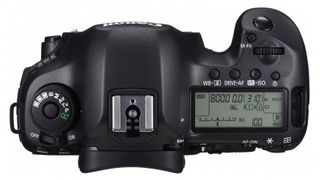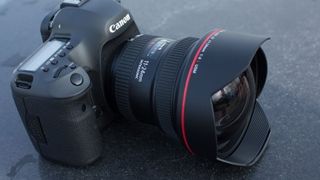Canon 5DS 50-megapixel monster set to redefine the professional DSLR market
Canon fans have been clamoring for a pro DSLR to match Nikon's 36-megapixel D810, and now the wait is over
The EOS 5DS packs dual DIGIC processors to handle those massive 50-megapixel files, and this helps give it an impressive 5fps continuous shooting speed. There are plenty of faster cameras than this, but 5fps is enough for most jobs and a real technical achievement given the sheer quantity of data being captured by the sensor.
You don't have to use all 50 million pixels, though. The 5DS offers a 1.3x crop mode to simulate the sensor size of the old EOS 1D series cameras, and a 1.6x crop mode to simulate Canon's smaller APS-C consumer models.
These produce 30 megapixel and 19 megapixel images respectively, so you'll still get plenty of detail – but the 1.6x crop mode does NOT mean that the EOS 5DS can take smaller EF-S format lenses. There are physical differences that makes this impossible, and the crop mode is simply there to simulate the smaller sensor sizes.
This is more useful than it might sound. You might be used to the 'reach' your 70-300mm telephoto gives you on your APS-C Canon, and now you can get the same effective magnification on the 5DS. You'll also get much more manageable file sizes – 50MP is brilliant, but you won't necessarily need it all the time.

The 5DS uses the same high-tech autofocus system as the EOS 5D Mark III, with 61 AF points including 41 cross-type sensors and 5 dual cross-type. It uses Canon's 'Intelligent Tracking and Recognition AF' (iTR) to track both faces and colour.
The 150,000 pixel RG+IR light metering sensor has the Flicker Detection first seen on the EOS 7D Mark II for more reliable exposures under artificial light (notably fluorescent light).
There's a new Fine Detail Picture Style designed to offer advanced sharpness adjustment without the need for a computer, and it's now possible to customise the Quick Control screen with your own favourite settings.
Get daily insight, inspiration and deals in your inbox
Get the hottest deals available in your inbox plus news, reviews, opinion, analysis and more from the TechRadar team.
Keep it sharp
With the 5DS, Canon has also introduced a new Mirror Vibration Control System which uses cams to drive the camera's mirror up and down in a controlled fashion, avoiding sudden stops that could jar the camera and blur the picture.
This highlights a key point with the 5DS and, indeed, the Nikon D800/810 before it – the resolution is so high that small camera movements or focus errors that would go unnoticed in other cameras can start to become visible.

The 5DS will never record less detail than a camera with a lower resolution sensor, but you will need to take more care over focusing and camera shake to really see its full potential. You'll also need to think seriously about getting some bigger memory cards (it takes both CF and SD) and a bigger hard disk for your computer (or maybe a newer, faster computer) to handle those 50-megapixel files.
The EOS 5DS and 5DS R aren't out until June, but we will bring you a full review just as soon as we can. In the meantime, Canon announced another product which will be available much sooner and could be just as exciting for serious/professional Canon owners...
Canon EF 11-24mm f/4L USM
Oh, right (you think), so this is another APS-C format super-wideangle lens? But it's not. Despite the super-short focal lengths, this is a full-frame lens and, to be more precise, the world's widest angle rectilinear zoom lens. You can get fisheye lenses which are wider still, but they produce a strong, circular distortion effect – this 11-24mm lens records straight lines as straight (hence 'rectilinear') and it's just stunning.

It's going to be especially useful for landscapes and architecture, but it will also be excellent for interior shots, where there never seems to be quite enough room to step back and get everything in.
The new lens has three aspherical lens elements, including one ground aspherical element (most are 'moulded', which is cheaper).
It goes on sale from March 2015 at a cost of £2800 and, given what this lens can do, we're not remotely surprised it costs that much. Even at this price, you'll probably need to pre-order to be sure of getting one.
We'll get one in for review just as soon as we can.
Most Popular

